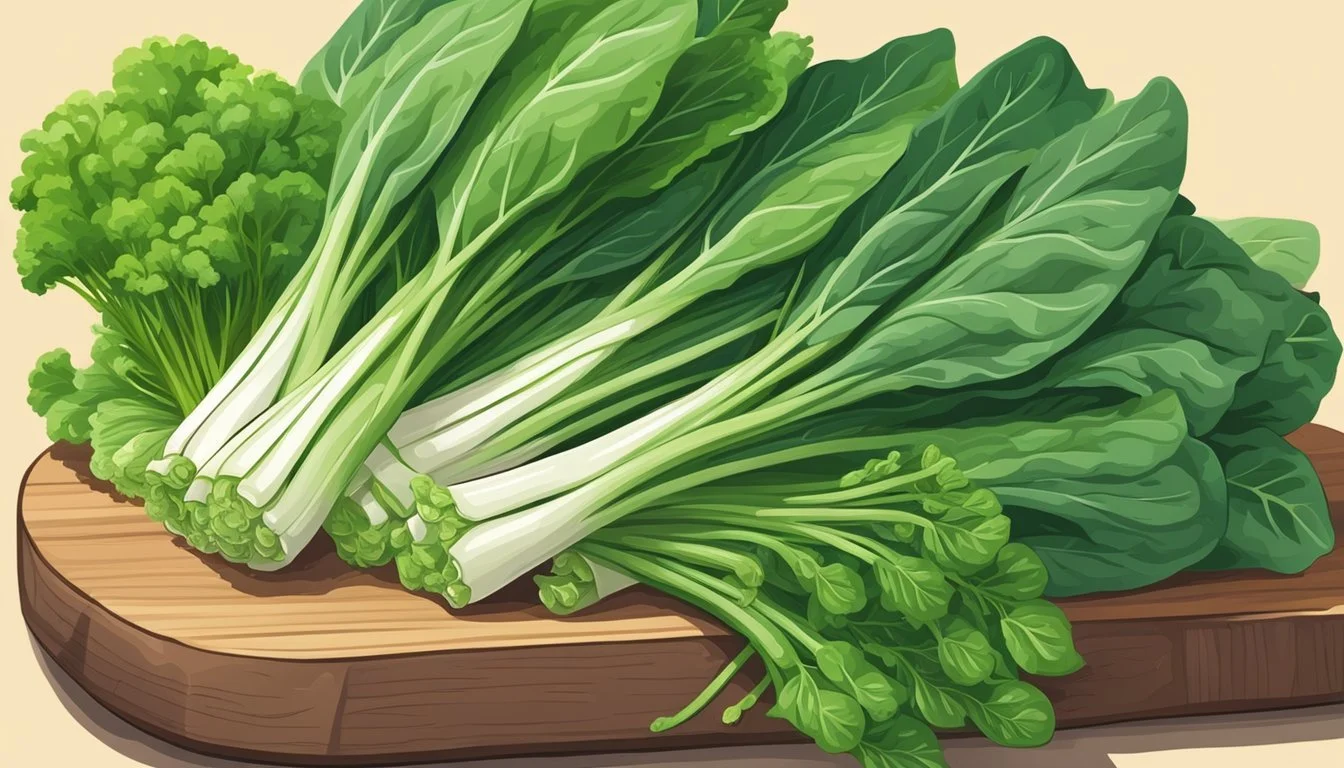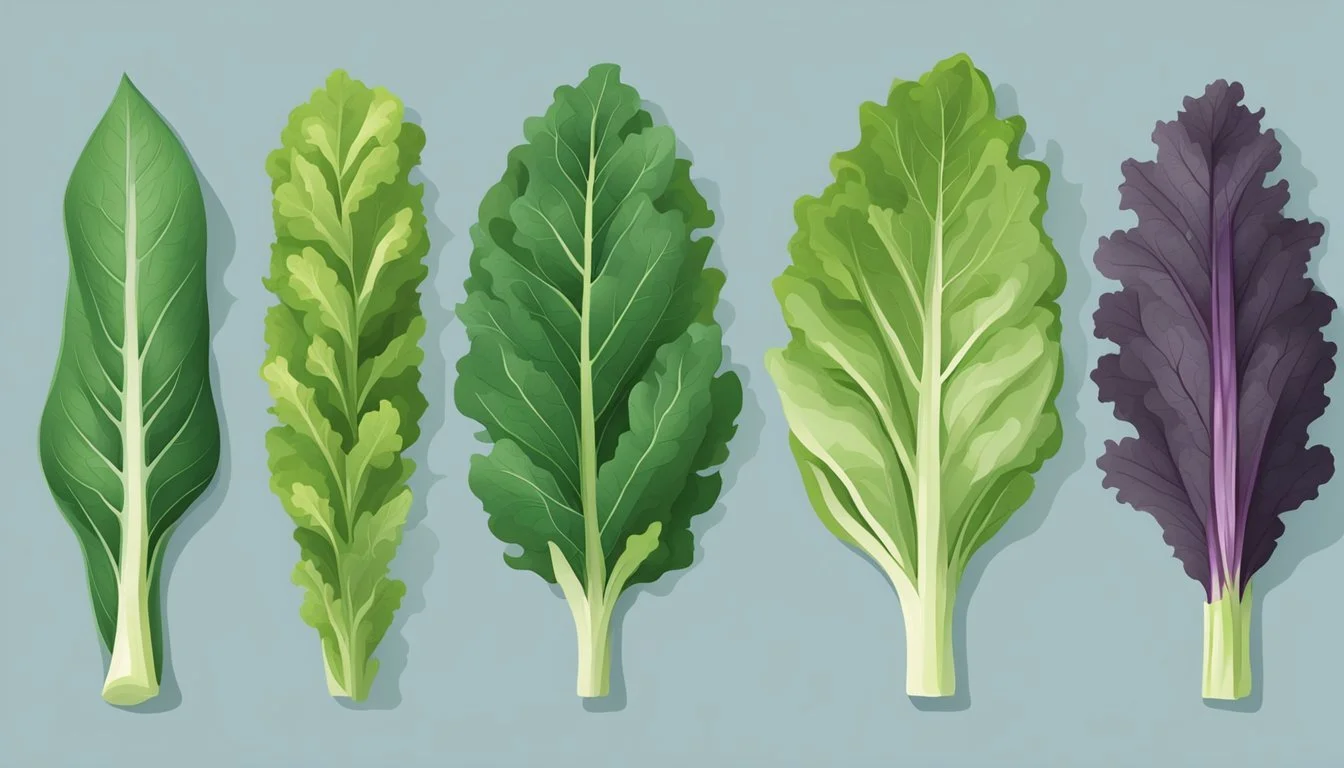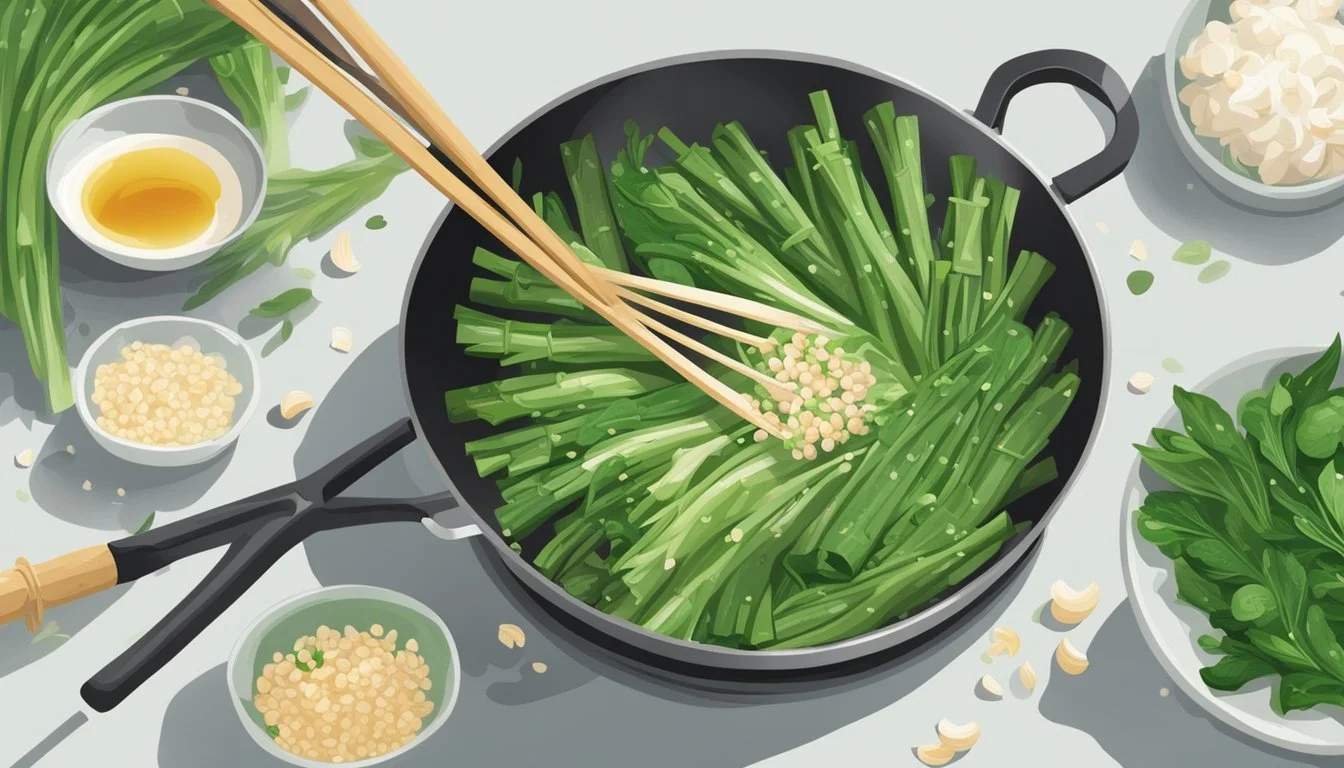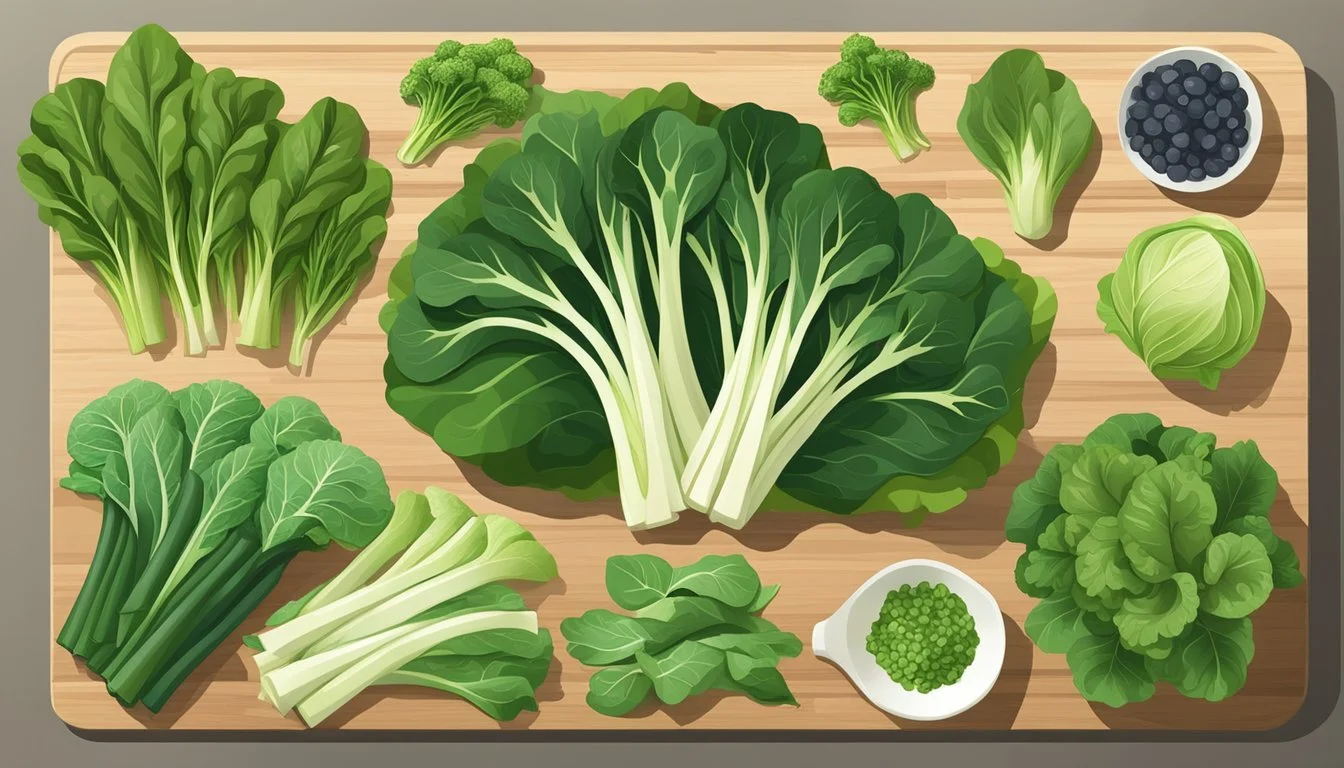Choy Sum Substitutes
Best Alternatives for Stir-Fries and Soups
Choy sum, a popular leafy green vegetable in Asian cuisine, often finds its way into stir-fries, soups, and noodle dishes due to its tender texture and mild, slightly sweet flavor. There may come a time when choy sum is not available, and you need a substitute that closely mimics its taste and texture for your recipes. For those seeking a direct replacement, bok choy ranks as one of the top alternatives because of its similar flavor profile and versatility in various dishes.
Another excellent substitute is Gai Lan, also known as Chinese broccoli, which offers a slightly more robust taste while still providing a tender and leafy consistency. For those who enjoy experimenting, baby spinach and Swiss chard can also serve as suitable substitutes, though with a somewhat different texture and taste.
Finding the right substitute will ensure your dishes retain their authentic flavor and appeal. Whether you are trying to replicate a traditional recipe or simply exploring new ingredients, understanding these alternatives can make your culinary experience both diverse and delightful.
Understanding Choy Sum
Choy sum, known for its tender green leaves and slightly bitter taste, is a staple in many Asian dishes. This section covers its botanical profile, nutritional benefits, and common culinary uses.
Botanical Profile and Nutrition
Choy sum, also referred to as Cai Xin, is part of the Brassica family. It closely resembles Chinese broccoli but is notably sweeter and more tender. The plant has elongated, vibrant green leaves with small yellow flowers that are also edible.
From a nutritional standpoint, choy sum is a powerhouse. It is rich in vitamins A, C, and K, which support immune function, skin health, and bone health respectively. Additionally, choy sum provides dietary fiber, promoting digestive health. It also contains essential minerals like calcium and iron, important for bone strength and blood production.
Culinary Uses in Asian Dishes
Choy sum is a versatile ingredient in Asian cuisine. It is often used in stir-fries, soups, and noodle dishes. The tender stems and leaves cook quickly, making it a convenient addition to many recipes.
In stir-fries, choy sum pairs well with garlic and soy sauce, offering a slightly bitter yet sweet flavor. It is also a common ingredient in hot pots, where it adds texture and nutrients to the broth. When sautéed with a bit of oil and ginger, choy sum makes a delightful side dish.
Using choy sum in smoothies is less common, but its nutritional profile makes it an interesting choice for those looking to boost vitamins and minerals in their diet.
Why Substitute Choy Sum?
Substituting choy sum can be essential due to limited availability during certain seasons and dietary preferences or allergies that some individuals may have.
Availability and Seasonal Constraints
Availability of choy sum can vary significantly depending on the season and location. In many regions, choy sum may not be readily available year-round, prompting the need for substitutes.
During off-seasons, grocery stores might stock limited quantities, or the quality of the produce may decline. Supply chain issues can exacerbate these problems, particularly in non-Asian countries where choy sum is less common. Due to these constraints, readily available alternatives like broccoli, broccolini, or napa cabbage often serve as excellent replacements to continue enjoying similar culinary experiences without interruption.
Dietary Preferences and Allergies
Dietary preferences and allergies can necessitate substituting choy sum with other vegetables. Some individuals may have specific allergies to certain types of greens, necessitating a switch to a safer option.
In other cases, people following certain diets, such as keto or vegan, may seek alternatives that better align with their nutritional goals or dietary restrictions. Alternatives such as spinach, kale, and bok choy provide similar textures and flavors while catering to specific dietary needs. Identifying suitable substitutes ensures that everyone's dietary restrictions and preferences are respected while maintaining the integrity and enjoyment of the dish.
Choy Sum Substitutes Based on Texture
In looking for substitutes for Choy Sum based on texture, Chinese broccoli, broccoli, and Swiss chard offer notable alternatives. Each brings unique characteristics that can enhance your dishes while providing a comparable bite and mouthfeel.
Chinese Broccoli (Gai Lan)
Chinese broccoli, also known as Gai Lan, is a popular substitute for Choy Sum due to its similar crunchy texture. The stems of Gai Lan are thicker and more substantial than those of Choy Sum, providing a satisfying bite.
The leaves are tender and robust, making it a versatile option for stir-fries and steaming. Gai Lan is prized for its mild, slightly bitter taste that complements a variety of seasonings. This makes it an excellent choice when the texture and bite of your dish are critical.
Broccoli
Broccoli serves as another valuable substitute for Choy Sum, primarily due to its crunchy texture. When cooked, broccoli’s florets offer a delightful crunch, while the stalks remain dense and fibrous, similar to Choy Sum's texture.
Broccoli is widely accessible and pairs well with a range of flavors, from soy sauce to garlic. Its versatility in various cooking methods, including steaming, roasting, and stir-frying, makes it a practical and familiar choice for those seeking a textural equivalent to Choy Sum.
Swiss Chard
Swiss chard provides a different yet effective textural substitute for Choy Sum. Its broad, tender leaves and thick, crunchy stems create a balanced texture that works well in many dishes.
Swiss chard is excellent in sautéed or stir-fried preparations, offering a mildly sweet and somewhat earthy flavor. During cooking, the stems soften while retaining a pleasant crunch, making it a suitable option for replacing Choy Sum in recipes that benefit from a varied texture profile.
Choy Sum Substitutes Based on Flavor
There are several worthy substitutes for choy sum that can add unique flavors to your dishes. Below are some options categorized by their distinctive taste profiles.
Spinach
Spinach has a mild flavor and tender texture, making it an excellent substitute for choy sum. Its versatility allows it to be used in various dishes, from stir-fries to soups. Spinach is less peppery and more neutral, which blends well with other ingredients.
Taste: Mild and slightly sweet
Texture: Soft when cooked
Suitable Dishes: Stir-fries, soups, salads
Pak Choi (Baby Bok Choy)
Pak Choi, also known as baby bok choy, has a sweet taste and crunchy texture similar to choy sum. It's commonly used in Asian cuisine and can be found in various forms, from side dishes to main courses.
Taste: Sweet and earthy
Texture: Crisp stalks with tender leaves
Suitable Dishes: Steam, stir-fries, soups, salads
Mustard Greens
Mustard greens bring a peppery flavor to dishes, making them a bolder substitute for choy sum. They are excellent in recipes requiring a little kick and can stand up to strong seasonings.
Taste: Peppery and robust
Texture: Slightly tough, more tender when cooked
Suitable Dishes: Stir-fries, braised dishes, soups
Specialty Greens as Alternatives
Specialty greens such as napa cabbage, kale, and collard greens make excellent substitutes for choy sum. These alternatives provide distinct textures and flavors, lending themselves well to various culinary uses.
Napa Cabbage
Napa cabbage, often found in East Asian cuisine, is a versatile green with a mild, slightly sweet flavor. It has crinkly, pale green leaves that add a tender texture to dishes. Chefs frequently use it in stir-fries, soups, and salads.
When substituting for choy sum, replace it in equal parts. Napa cabbage delivers a softer bite compared to choy sum's firmer leaves, but it integrates well with similar seasonings like soy sauce and ginger.
It's also high in vitamins C and K, making it a nutritious choice. The cabbage's robustness suits hearty recipes, effectively absorbing flavors while maintaining its form during cooking.
Kale
Kale is a nutrient-dense green known for its curly or flat leaves with a slightly bitter taste. It stands out due to its hearty texture, which holds up well in cooking. This alternative offers a more robust chew than choy sum but pairs excellently with garlic and chili flakes.
To replace choy sum, chop the kale leaves and adjust cooking times since kale takes longer to soften. It works particularly well in sautés and baked dishes.
Rich in antioxidants, vitamins A, C, and K, as well as calcium, kale adds significant health benefits. Its versatility stretches from salads and smoothies to main courses, making it a multifaceted substitute.
Collard Greens
Collard greens, a staple in Southern U.S. cuisine, provide a slightly bitter flavor with a firm yet tender texture. The broad, dark green leaves are ideal for wrapping around fillings or chopping into stews and braises.
As a substitute for choy sum, collard greens require a bit more cooking time to become tender. Their flavor melds well with smoked meats and spicy seasonings, creating rich, deep flavors.
These greens are rich in vitamins A, C, and K, and are known for their calcium content. They shine in slow-cooked dishes, where their texture and flavor develop fully, offering a hearty alternative to choy sum.
Cooking with Choy Sum Substitutes
When substituting choy sum in various recipes, it's important to be mindful of texture, bitterness, and cooking methods to ensure successful results.
Adjusting Recipes for Texture and Bitterness
Choy sum's delicate texture and mild bitterness set it apart from other greens. To replicate this, kale or Swiss chard are excellent choices. Kale's sturdy leaves withstand cooking without becoming mushy, making it ideal for stir-fries and soups. Swiss chard, with its tender leaves and slightly bitter taste, mimics choy sum's strengths in both cooked and fresh dishes.
Tip: Balance the bitterness of these substitutes by pairing them with sweet or savory ingredients like garlic or soy sauce.
Incorporating Substitutes Into Stir-Fries and Salads
Stir-fries and salads benefit greatly from the use of napa cabbage or bok choy as choy sum substitutes. Napa cabbage, with its crunchy stems and mild flavor, blends seamlessly into stir-fries, adding both texture and freshness.
Bok choy, known for its juicy leaves and tender stalks, serves as a close alternative, providing similar bulk and crunch. When working with these vegetables, chop them to match the size of choy sum pieces, ensuring even cooking and consistent texture.
Utilizing Substitutes in Soups and Noodle Dishes
For soups and noodle dishes, celery and napa cabbage offer satisfying alternatives to choy sum. Celery serves as an excellent option due to its crunch and slightly nutty flavor. This makes it a versatile addition to broths and hot pots.
Napa cabbage, appreciated for its sweet flavor that intensifies when cooked, is perfect for noodle dishes, infusing them with a gentle sweetness similar to that of choy sum. When using these substitutes, consider the cooking time to maintain their crunchiness and avoid overcooking.
Storing Substitutes for Freshness
To ensure substitutes for choy sum stay fresh, correct storage methods are essential. Utilize refrigeration techniques and methods to prolong shelf life.
Refrigeration Tips
For optimal freshness, store leafy greens like kale and Swiss chard in the vegetable crisper of your fridge. Wrap them in damp paper towels and place them in perforated plastic bags. This method maintains the right humidity levels.
Cover celery in aluminum foil before refrigerating to prevent moisture loss and extend freshness. Chinese mustard greens (Gai Choy) can be stored similarly, wrapped in a paper towel and sealed within a plastic bag, ensuring the fridge maintains appropriate humidity.
Prolonging Shelf Life
To maximize shelf life, wash and thoroughly dry greens before storage to prevent rapid spoilage. Seal container lids tightly to keep air out and reduce oxidation, especially for hearty greens like collard greens.
For pea shoots, a gentle rinse followed by a spin in a salad spinner removes excess water. Store them in airtight containers lined with a dry paper towel. This method reduces moisture buildup, extending their shelf life.
Avoid storing vegetables next to fruits like apples or bananas, which emit ethylene gas, hastening the ripening process.
Health Considerations and Benefits
Choy sum, a popular leafy green in Chinese cuisine, offers a variety of health benefits. It is packed with essential vitamins and minerals, low in calories, and provides a good source of dietary fiber. These aspects contribute to making choy sum a valuable addition to a balanced diet.
Vitamin and Mineral Content
Choy sum is rich in several vitamins and minerals. Vitamins C and K are particularly abundant, supporting immune health and blood clotting, respectively. It also contains calcium, important for bone health, and potassium, which helps regulate blood pressure.
In addition, choy sum provides a moderate amount of iron, essential for oxygen transport in the blood. These nutrients collectively contribute to maintaining overall health and preventing deficiencies.
Low-Calorie Options for Diet
Choy sum is a low-calorie vegetable, making it an excellent choice for those looking to manage their weight. With only about 48 calories per 100 grams, it can be consumed in generous portions without adding significant calories to the diet.
This feature is beneficial for those on calorie-restricted diets or individuals aiming to lose weight. Due to its low-energy content, choy sum can be included in various meal plans without compromising on nutritional value.
Benefits of Dietary Fiber
Dietary fiber in choy sum aids in digestive health. Fiber is known to enhance bowel movements and prevent constipation. Additionally, it can help maintain a healthy weight by promoting a feeling of fullness, which can reduce overall calorie intake.
The fiber content also plays a role in controlling blood sugar levels and lowering cholesterol. Incorporating choy sum into meals can thus support heart health and aid in managing diabetes.
In summary, choy sum's nutritional profile provides significant health benefits, contributing to a well-rounded, nutritious diet.
The Verdict on Choy Sum Substitutes
Finding the right substitute for choy sum can be essential for maintaining the flavor and texture of your dishes. Key attributes to consider include affordability, versatility, and nutritional value.
Summarizing Alternatives Based on Qualities
Kale is a popular substitute due to its versatility and easy substitution at a one-to-one ratio. It fits into both cooked dishes and smoothies, making it a robust alternative.
Swiss chard offers a vibrant appearance and a slightly bitter taste, which can add depth to soups, stir-fries, and wraps. Its high vitamin content makes it a nutritious option.
Napa cabbage is another worthy substitute, providing a mild flavor and crunch similar to choy sum. It is often used in various Asian dishes, offering an almost like-for-like replacement.
Yu choy has a tender, crunchy texture similar to choy sum and features a mix of sweet, slightly bitter, and peppery notes. Its light green stalks and oval leaves make it a visually appealing option.
Final Recommendations
For those prioritizing affordability and availability, kale and Napa cabbage are excellent choices. They are easy to find in most grocery stores and offer a familiar taste and texture.
Swiss chard stands out for its nutritional benefits and versatility across different recipes. It's particularly useful for those looking to boost their diet's vitamin intake.
Yu choy is recommended for those seeking a closer flavor match to choy sum, with its balanced sweetness and slight bitterness. It works well in both traditional and modern recipes.
Each substitute offers unique qualities that can enrich your meals, so consider the specific requirements of your dish when making your selection.









